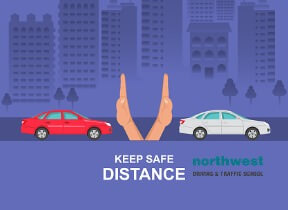- Traffic School
The Basics of Stopping Distances

One of the most important parts of any learner driver’s automotive education is learning about vehicle stopping distances. Following other cars too closely, an act also known as tailgating is one of the biggest causes of automotive accidents in the US and doing it during your test will certainly result in you failing.
To make sure you have a clear understanding of stopping distances and why they are a crucial part of staying safe while driving, here is our guide to the basics of stopping distances.
Table of Contents
What Is a Stopping Distance?
A vehicle’s stopping distance is the combination of its driver’s “thinking distance” and the actual vehicle’s “braking distance.”
These two distances can be affected by outside factors, such as weather, road conditions, if the driver is tired, or if they are inebriated.
The faster you travel, the longer you stopping distance is going to be. Travelling at 40mph rather than 30mph means it’ll take an extra 13 meters, which is more than three average car lengths to come to a stop.
To make things simpler, below is a list of average thinking and braking distances for an average-sized family car in normal weather conditions.
Average Thinking Distances
A ‘thinking distance’ is how long it takes for a vehicle’s driver to notice and react to a hazard by applying the brake.
| Speed | Thinking distance (before reacting) |
| 20mph | 6 metres |
| 30mph | 9 metres |
| 40mph | 12 metres |
| 50mph | 15 metres |
| 60mph | 18 metres |
| 70mph | 21 metres |
Average Braking Distances
The braking distance is how far your car travels while you’ve got your foot on the brake. Your vehicle’s actual braking distance is altered by its weight and the road conditions. For instance, a small town car on a dry road will come to stop faster than a pick truck on wet concrete.
| Speed | Braking distance |
| 20mph | 6 metres |
| 30mph | 14 metres |
| 40mph | 24 metres |
| 50mph | 38 metres |
| 60mph | 55 metres |
| 70mph | 75 metres |
How to Remember Your Stopping Distances
The chances are that you won’t have time during your test to whip out your laptop and look up these charts, but don’t worry there is a mathematical formula you can use to work out stopping distances.
Before you groan, keep calm, it actually pretty easy. All you need to do is multiply the speed by intervals of 0.5, starting with 2, to get your stopping distance in feet:
- 20mph x 2 = 40 feet
- 30mph x 2.5 = 75 feet
- 40mph x 3 = 120 feet
- 50mph x 3.5 = 175 feet
- 60mph x 4 = 240 feet
- 70mph x 4.5 = 315 feet
If you really need to have your stopping distance in meters, just divide the distance in feet by 3.3 to get the stopping distance in meters. That bit isn’t so simple, so you might need a calculator for it.
Expert Training
The Northwest Driving School and Traffic School provide the Las Vegas community with live driving and traffic classes taught by seasoned instructors. All of our driving instructors have passed background checks, each automobile is DMV safety-approved and every member of the Northwest family is committed to providing excellent drivers ed and behind the wheel instruction.
At Northwest, you can expect to find outstanding classes, both on campus and behind the wheel, that are engaging, fact-filled, entertaining and geared toward success. We make no bones about it, we believe that Northwest provides the best driving lessons in Las Vegas, no matter your age or background. We are proud of the fact that 98% of our students pass their test on the first try. Call us at (702) 403-1592 to start your driving adventure with one of our expert instructors.
Written by:
Rich Heinrich,
Master Instructor, Emeritus




